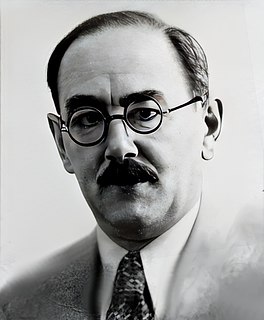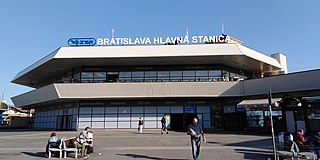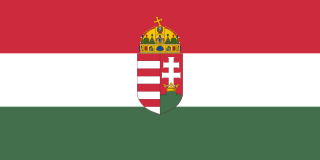Related Research Articles

Imre Nagy was a Hungarian communist politician who served as Prime Minister and Chairman of the Council of Ministers of the Hungarian People's Republic from 1953 to 1955. In 1956 Nagy became leader of the Hungarian Revolution of 1956 against the Soviet-backed government, for which he was sentenced to death and executed two years later.
Bratislava, currently the capital of Slovakia and the country's largest city, has existed for about a thousand years. Due to the city's strategic geographical location, it was an important European hub due to its proximity to the advanced cultures of the Mediterranean and the Orient as well as its link to the rest of Europe, which were possible by the Danube River.

The Hungarian People's Republic was a one-party socialist republic from 20 August 1949 to 23 October 1989. It was governed by the Hungarian Socialist Workers' Party, which was under the influence of the Soviet Union. Pursuant to the 1944 Moscow Conference, Winston Churchill and Joseph Stalin had agreed that after the war Hungary was to be included in the Soviet sphere of influence. The HPR remained in existence until 1989, when opposition forces brought the end of communism in Hungary.

Bratislava main railway station is the major railway station in Bratislava, Slovakia. It is located near Šancová Street, around 1 km or a 15 min walk north from the historical part of the Old Town.
The Apponyi family, also Apponyi de Nagy-Appony, were a prominent and powerful Hungarian family group of the high upper nobility of the Kingdom of Hungary, whose's members remained notable even after the kingdom's dismemberment in the successor states of Hungary and Czechoslovakia. While tracing its origins to the High Middle Ages, the family became prominent in the 18th century with its elevation to the rank of Counts of Nagy-Appony in 1739 and the acquisition of seventeen grand domains between 1760 and 1800. In the last century of the Habsburg Monarchy, four of its members received the Order of the Golden Fleece, a total held in a draw among the European nobility by the houses of Esterházy, Batthyány, Cziráki and Pálffy. In addition, Albert Apponyi received the Order in 1921 shortly after the end of the monarchy. In addition to this the Apponyi family sat within all Hungarian Kings and then Habsburg private courts which was reserved only for the most powerful and important members of the Kingdom.

Parliamentary elections were held in Czechoslovakia on 18 and 25 April 1920. Members of the Chamber of Deputies were elected on 18 April and members of the Senate on 25 April. The election had initially been planned for mid- or late 1919, but had been postponed.

Bratislava is the capital and largest city of Slovakia. Officially, the population of the city is about 430,000; however, it is estimated to be more than 660,000 - approximately 150% of the official figures. Bratislava is in southwestern Slovakia at the foot of the Little Carpathians, occupying both banks of the River Danube and the left bank of the River Morava. Bordering Austria and Hungary, it is the only national capital that borders two sovereign states.

The Marxist Left in Slovakia and the Transcarpathian Ukraine was a political organisation in eastern parts of the First Czechoslovak Republic. It was one of the forerunners of the Communist Party of Czechoslovakia.
The Hungarian-German Social Democratic Party was a social democratic political party in Slovakia. It was founded in 1919 by social democrats from ethnic minority communities. The party had a German and a Hungarian section. The German and Hungarian social democrats in Slovakia had developed an antagonistic relationship with the Slovak social democrats, who had merged into the Czechoslovak Social Democratic Workers Party as Austria-Hungary was broken up after the First World War. Issues of contention between Hungarian/German and Slovak social democrats included views of the February Strike of 1919 and the Hungarian Soviet Republic.
Paul Wittich (1877–1957) was a Carpathian German social democratic politician in Slovakia. He was a prominent labour leader in Pressburg. During a few days around New Year's Eve 1919, he led a workers militia that vied for control of the city. After the integration of Pressburg into Czechoslovakia, he sat in the national parliament.
Westungarische Volksstimme was a German-language weekly newspaper published from Pressburg.
Slovenské robotnícke noviny was a Slovak-language social democratic newspaper issued from Pressburg, founded in October 1904. The newspaper was economically and politically supported by the Czech social democrats in Vienna. Emanuel Lehocký was the editor of the newspaper.
Stavitel'ský Robotník was a Slovak language newspaper published by the Hungarian Building Workers Union. It was the first Slovak-language trade union newspaper; the Hungarian Building Workers Union created the paper due to its substantial Slovak membership. Its first issue was published on September 1, 1903, and subsequent publication was sporadic.
Union was a central trade union organization of Hungarian and German workers in Slovakia. As of early 1920 Union claimed a membership of around 40,000 workers in southwestern Slovakia. Gyula Nagy, an important figure in the leftwing in Slovakia at the time, was the secretary of Union. Union had a strong presence amongst agricultural labourers. The organization was linked to the Hungarian-German Social Democratic Party.
The Slovak Social Democratic Party of the Kingdom of Hungary, or Slovak Executive Committee, was a Slovak social democratic political party in the Kingdom of Hungary, existing as an independent party from June 1905 to March 1906 and affiliated with the Hungarian Social Democratic Party an autonomous Nationality Committee from 1906 to 1918. Emanuel Lehocký was the chairman of the party. The central organ of the party was Slovenské robotnícke noviny.
The following is a timeline of the history of the city of Bratislava, Slovakia.

The Hungarian Republic was a short-lived republic that existed between August 1919 and February 1920 in the central and western portions of the former Hungarian Kingdom. The state was established in the aftermath of the Hungarian Revolutions of 1918–1919 by counter-revolutionary forces who sought to return to the status quo prior to 31 October 1918.
Karl Čermak was a German socialist politician. A skilled organizer, Čermak emerged as a key leader of the labour movement in German Bohemia in the years preceding World War I. He went on to become a parliamentarian in the First Czechoslovak Republic.

The Nové Zámky 16th electoral district was a parliamentary constituency in the First Czechoslovak Republic for elections to the Chamber of Deputies. The seat of the District Electoral Commission was in the town of Nové Zámky. The constituency elected 11 members of the Chamber of Deputies.

The Košice 20th electoral district was a parliamentary constituency in the First Czechoslovak Republic for elections to the Chamber of Deputies. The seat of the District Electoral Commission was in the town of Košice. The constituency elected 7 members of the Chamber of Deputies.
References
- ↑ Duin, Pieter van. Central European Crossroads: Social Democracy and National Revolution in Bratislava (Pressburg), 1867-1921 . New York: Berghahn Books, 2009. p. 364
- ↑ Magyar Tudományos Akadémia. Studia historica Academiae Scientiarum Hungaricae , Volume 110-125. Budapest: Akadémiai Kiadó, 1975. p. 25
- ↑ Duin, Pieter van. Central European Crossroads: Social Democracy and National Revolution in Bratislava (Pressburg), 1867-1921 . New York: Berghahn Books, 2009. p. 366